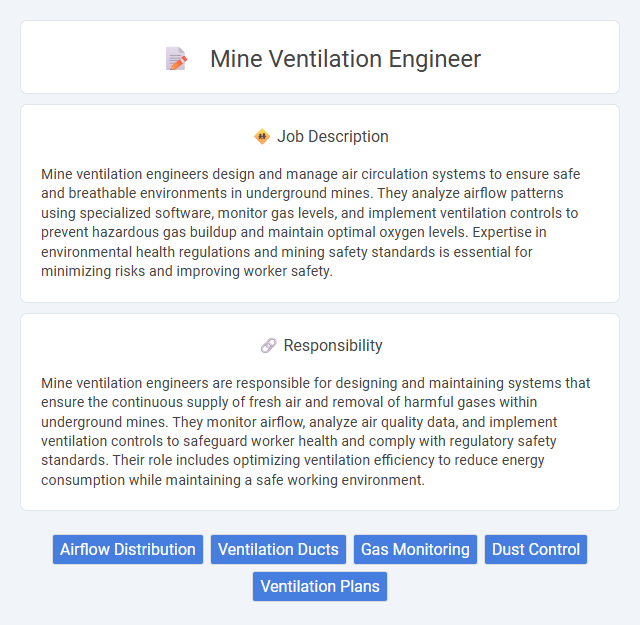
Mine ventilation engineers design and manage air circulation systems to ensure safe and breathable environments in underground mines. They analyze airflow patterns using specialized software, monitor gas levels, and implement ventilation controls to prevent hazardous gas buildup and maintain optimal oxygen levels. Expertise in environmental health regulations and mining safety standards is essential for minimizing risks and improving worker safety.
Individuals with strong problem-solving skills and a keen interest in safety protocols are likely to thrive as mine ventilation engineers. Those comfortable working in challenging underground environments and able to handle technical equipment may find this career well-suited to their abilities. However, people who prefer less physically demanding or less high-risk work might struggle to adapt to the conditions of this role.
Qualification
A Mine Ventilation Engineer requires a bachelor's degree in mining engineering, environmental engineering, or a related field, with specialized coursework in mine ventilation systems, airflow mechanics, and gas monitoring technologies. Professional certifications such as Certified Mine Ventilation Engineer (CMVE) or registration with relevant mining safety authorities enhance job prospects and credibility. Strong skills in computational fluid dynamics (CFD) software, experience with underground mine safety regulations, and knowledge of hazardous gas detection are critical for ensuring safe and efficient mine operations.
Responsibility
Mine ventilation engineers are responsible for designing and maintaining systems that ensure the continuous supply of fresh air and removal of harmful gases within underground mines. They monitor airflow, analyze air quality data, and implement ventilation controls to safeguard worker health and comply with regulatory safety standards. Their role includes optimizing ventilation efficiency to reduce energy consumption while maintaining a safe working environment.
Benefit
Mine ventilation engineers likely enhance safety by ensuring proper airflow and reducing hazardous gas accumulation. They probably improve operational efficiency through optimized ventilation systems that regulate temperature and air quality. Their work may also contribute to regulatory compliance, lowering risks of fines and operational shutdowns.
Challenge
Mine ventilation engineers likely face significant challenges in designing systems that effectively control airflow to ensure miner safety while managing hazardous gases and dust. The complexity of underground environments may require constant adaptation to changing mine layouts and ventilation demands. Risk probability linked to inadequate ventilation underscores the critical nature of their problem-solving and technical expertise.
Career Advancement
A mine ventilation engineer plays a critical role in ensuring underground air quality and safety, providing expertise in airflow management and hazardous gas monitoring. Career advancement opportunities include transitioning into senior engineering roles, specializing in environmental impact assessments, or moving into project management and regulatory compliance positions within mining companies. Expertise in advanced ventilation systems and familiarity with mining safety regulations can significantly enhance prospects for leadership roles and higher salary brackets.
Key Terms
Airflow Distribution
A Mine Ventilation Engineer specializes in designing and optimizing airflow distribution systems to ensure safe and efficient air circulation within underground mines. They analyze ventilation network models, calculate air velocity, pressure drops, and contaminant dispersion to maintain regulatory compliance and minimize hazardous gas accumulation. Expertise in airflow distribution enhances underground working conditions, reduces energy consumption, and supports emergency response planning.
Ventilation Ducts
Mine ventilation engineers design and maintain ventilation ducts to ensure efficient airflow and safe working conditions underground. They analyze duct dimensions, airflow rates, and pressure loss to optimize air distribution and control hazardous gases. Proper ventilation duct installation and maintenance prevent mine collapses and protect miners from toxic fumes and heat buildup.
Gas Monitoring
Mine ventilation engineers specialize in designing and maintaining ventilation systems to ensure optimal airflow in underground mines, crucial for diluting and removing hazardous gases such as methane and carbon monoxide. Precise gas monitoring technologies, including fixed gas detectors and portable analyzers, are employed to continuously assess air quality and detect dangerous gas concentrations, thereby preventing explosions and health risks. Expertise in interpreting gas data and adjusting ventilation controls directly supports regulatory compliance and enhances miner safety in complex subterranean environments.
Dust Control
Mine ventilation engineers specialize in designing and implementing effective dust control systems critical for maintaining air quality in underground and surface mining operations. They utilize advanced ventilation techniques and dust suppression technologies to minimize respirable dust exposure, ensuring regulatory compliance and protecting miners' health. Their expertise includes monitoring airborne particulate levels and optimizing airflow patterns to prevent hazardous dust accumulation and improve overall mine safety.
Ventilation Plans
Mine ventilation engineers design and implement detailed ventilation plans to ensure the continuous supply of fresh air and removal of hazardous gases in underground mines. Ventilation plans optimize airflow patterns by calculating air volume requirements, monitoring gas concentrations, and installing fans, ducts, and sensors to maintain safe working conditions. Effective ventilation strategies reduce risks related to gas explosions, respiratory health issues, and heat stress, directly contributing to operational safety and regulatory compliance.
 kuljobs.com
kuljobs.com